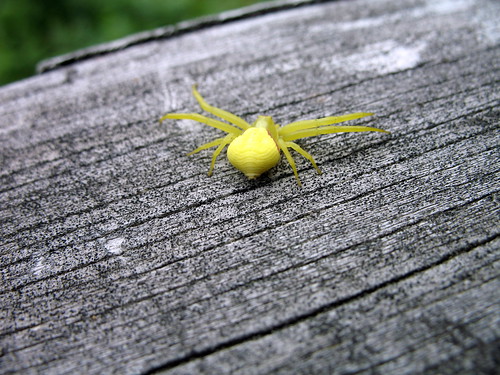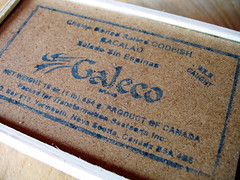but it’s not lobster I want to talk about; it’s smoked fish. Specifically, smoked haddock (a.k.a.
finnan haddie), which plays a central role in two very old-fashioned English recipes that had been gathering metaphorical dust in my collection, curiosities (to me, at least) that I thought I might never have occasion to use: Omelet Arnold Bennett, and kedgeree.
I’d searched for smoked haddock in Manhattan in the past and come home empty-handed: Whole Foods didn’t have it, neither did Dean & Deluca, or Gourmet Garage, or the venerated Russ & Daughters. (I can't recall whether I tried Tea & Sympathy but there's nothing involving haddock on
their lunch menu at present). I’d wanted it for a smoked haddock and watercress tart in Tamasin Day-Lewis’s
The Art of the Tart. I made the tart
anyhow, using Stonington Sea Products
smoked Maine shrimp, which, unlike their smoked haddock, are readily available at a grocery nearby. The tart was superb even in its Americanized version
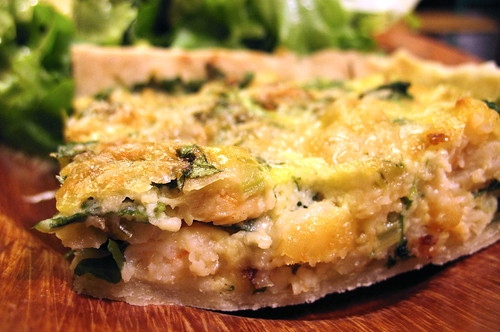
but I remained curious about smoked haddock, and I didn’t want to bother attempting either kedgeree or the omelet with a substitute for it. It seemed preferable to tuck these recipes away for some improbable future situation. And there it was on our Vinalhaven vacation, 3 or 4 styrofoam trays of smoked haddock sitting in a refrigerated case at
Carver's Harbor Market. Have you ever experienced a sense of culinary now-or-never-ism, in which you recall one of the more obscure recipes in your collection while at once understanding that if you don’t make it now you probably never will? Neither of these recipes is complicated or requires strenuous effort—they’re both simple enough to be taught to even the most sullen hired help at the most remote English country house—but I couldn’t see myself ever making them at any other time.
 Omelet Arnold Bennett
Omelet Arnold BennettThis is almost as English as
David Dickinson waggling his eyebrows at you at a car boot sale. I have no idea how I stumbled across this recipe but every time I scrolled past it while on my way to another egg dish in my collection, I would conjure up an unlikely and very specific set of circumstances in which it would be a pleasure to cook and eat this one. Most of these scenarios involved icy rain pounding on the roof, but maybe you have different ideas. Mr. Bennett reportedly simplified matters by demanding that it be made wherever he went.
 More than you ever wanted to know about Arnold Bennett's whereabouts, from a 1970's edition of The Oxford Literary Guide to the British Isles I found at the cabin. Another section of the book revealed that Bennett and I have something in common besides a love of omelettes: he briefly practiced law but found it "uncongenial."
More than you ever wanted to know about Arnold Bennett's whereabouts, from a 1970's edition of The Oxford Literary Guide to the British Isles I found at the cabin. Another section of the book revealed that Bennett and I have something in common besides a love of omelettes: he briefly practiced law but found it "uncongenial."He also reportedly liked to eat his omelet late at night but it’s a fine lunch dish too. It's basically a standard omelet with a souffléed layer of smoked haddock and a little grated cheese on top. It’s lighter than it looks but somehow you may wish to spend the rest of the afternoon lying on the sofa with a glass of scotch in order to digest it properly.

The recipe I used comes
from Delia Smith but there are several similar versions out there, including one
purporting to be the original from the Savoy Hotel's archives. I departed from Delia's recipe on a few small matters so we'll call this an adaptation.
omelet Arnold Bennet for two
(adapted from Delia Smith)
3 tablespoons heavy cream
8 oz smoked haddock, cut into small bite-sized pieces, any skin and bones removed
fresh ground black pepper, to taste
5 eggs
½ teaspoon all-purpose flour
pinch of fresh ground nutmeg (optional)
1 tablespoon butter
2 to 3 tablespoons grated Gruyère or Parmesan cheese
1 to 2 tablespoons finely-chopped fresh flat-leaf parsley (optional)
Bring the cream to a simmer in a small, heavy saucepan and add the smoked haddock. Season it with pepper and let it simmer gently for 5 minutes. (Smoked haddock can be salty so wait until you've had a bite of the finished omelet before seasoning it with salt).
Take one of the eggs and separate the yolk and the white in small bowls. Add the flour to the yolk and beat it well. When the fish is done simmering, turn off the heat and add the egg yolk and flour mixture to the pan, beating continuously until it thickens.
Heat up the broiler very hot.
Whisk the egg white until it is as close as it can get to soft-peak stage. (I find it near impossible to get a single egg white to this stage so I settled for beating the hell out of it until it was very very frothy). Gently fold it into the haddock mixture. (A small silicone spatula is ideal for this).
Beat the 4 eggs well and grate a tiny bit of nutmeg into them as you do. (The nutmeg is optional, but since I began adding it to scrambled eggs and omelettes I've been unable to do without it).
On the stove top, melt the butter in a heavy pan about 8" in diameter. (Enameled cast iron is ideal; do not use a non-stick pan because those should
not go under the broiler). When the butter is sizzling but not browned, add the 4 beaten eggs and treat them as you would for any other omelet: let them settle for a few moments, and when they are starting to look cooked at the edge of the pan, gently draw the edges to the center and tilt the pan so that the runny liquid bits are evenly distributed. Do not, however, let this omelet cook all the way through, and do not fold it. When it looks about halfway cooked, turn off the heat and sprinkle the parsley over the top. (Or, leave the parsley aside until the very end and sprinkle it over the cooked omelet; that's up to you). Gently spread the haddock mixture over the top of the omelet using a butter knife or small silicone spatula. Sprinkle the grated cheese over the top and put it under the broiler until it is puffed up and nicely browned (approximately 2 minutes; watch it vigilantly so it doesn't burn).
Cut the omelet into two halves and serve at once. No folding!
Note: If you are interested in reading more about omelettes before moving on to kedgeree, I enthusiastically recommend
Peter Hertzmann's article on the subject.
KedgereeThis is arguably even more English than Omelet Arnold Bennett because it was nicked from India: it is
kitchari that’s been cozied-up for drafty English country house breakfasts. I’ll let
the British Food Trust fill you in on the historical tidbits.

Having now tried kedgeree, it's easy to understand how someone waking up at an English country house and suffering with a hangover, or chilblains, or a gardening injury, or itchy tweeds, or possibly just feeling poorly, would really be looking forward to having it for breakfast. It's light but filling, very easy on the stomach, and it's very attractive on the plate when steaming hot.
I improvised the recipe below based on the British Food Trust article I linked to above because that's all I had with me in the sticks. Not having done any further research at the time, I didn't know that most recipes (e.g.,
this one) call for simmering the haddock in water or milk or cream before adding it to the rice. Instead I gave the haddock a good stir in the melted butter that I softened the scallions in, and that worked well. If you suspect your fish of being very chewy, by all means simmer it the traditional way. Also: I didn't add any lemon juice or curry powder, but a teaspoon or so of each could be very good.
I didn’t measure anything when I prepared this, and while I've tried to be as precise as I could in writing it down, my sense is that it’s not a recipe one needs to be precise about. By this I mean that you are not going to ruin the dish if you use more or less scallions or parsley or whatever. I think that with some sort of smoking
contraption, one could make a very good vegetarian version with smoked shiitake mushrooms. They would have the right texture and—with a little help from tamari sauce?—the depth of flavor to replace the fish, but you’d have to smoke them yourself because I don’t know of anyone who sells them. Of course you could also use lentils instead, as in the many Indian versions.
kedgeree for two
3 tablespoons butter
3 or 4 scallions, washed but not chopped until the last possible moment right before you are ready to use them, at which point you finely chop both the white and green parts
8 ounces smoked haddock, flaked or chopped into small pieces (each just a couple centimeters across)
1 1/2 cups freshly cooked hot white rice, preferably good basmati,* fluffed up but kept covered until you are ready to use it
2 hard-boiled eggs, chopped into small pieces
A really generous grinding of very fresh black pepper and a pinch of fine sea salt, to taste
1/4 cup finely chopped fresh flat-leaf parsley
Melt the butter in a sturdy skillet–enameled cast iron is ideal–and when it starts to sizzle, add the scallions. Give them a few good stirs before adding the smoked haddock. Stir the scallion and haddock mixture about until it is heated through (approximately 3 minutes) and then add the rice, the hard-boiled eggs, the seasoning and the parsley, all of this in rapid succession. Use a fork to thoroughly but delicately mix it all together. (Give it a good stirring but not a brutal one). Serve very hot.
* If you don’t have a really good Indian grocery nearby where you can buy top-quality basmati, I think Tilda is best among supermarket brands. It cooks up better than those ones in hippie-looking packages.
Brandade de MorueA bonus recipe that’s only semi-related, with an
extra-bonus crunchy morsel at the very end. I made this last year when we visited Vinalhaven in August and I found a thrillingly rustic-looking wooden box of wild-caught Canadian salted cod in the market.
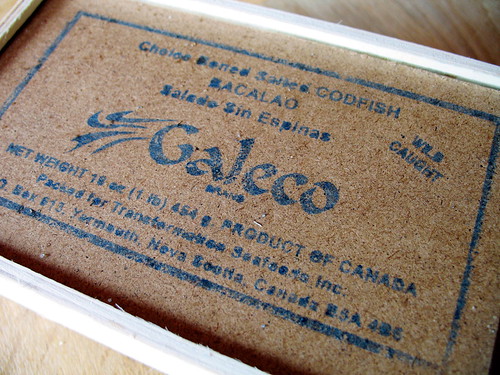
I’d been wanting to taste brandade again since the first time I’d tried it, when
Christine served it at a party and I wanted to sneak off and eat the entire dish in secret. Brandade is a traditional Provençal Christmas dish, but Vinalhaven in August can be cold in the evenings and mornings, and warm brandade on thin slices of toasted baguette was such an ideal thing to eat while gazing at ocean and pine trees that it could easily become a traditional Vinalhaven cocktail snack.
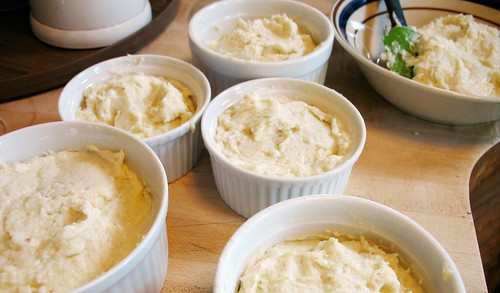

This is the sort of recipe you need to taste with great care to get the seasoning just right: salted cod can be excessively salty, but if it isn’t—and if you’ve successfully drawn out most of the salt during soaking—you will need to add more salt later on to bring out the flavors. Also, you should consider the quality of your tap water before you attempt this or any other brandade recipe. You're going to be soaking the fish in several changes of water, and if your tap water doesn't have a pleasant taste for drinking, it won't be good for your brandade either, so use filtered water. The water at the cabin is of very good quality and cold enough to rapidly numb one's fingers, so I opted for the lazy and slightly wasteful soaking method of leaving the fish in a bowl in the sink overnight with a constant stream of cold water trickling into it. It felt like a science project but that's part of the fun. (If you have a cat obviously this method would be no fun for you at all, and your cod will have to have its soak in the refrigerator).
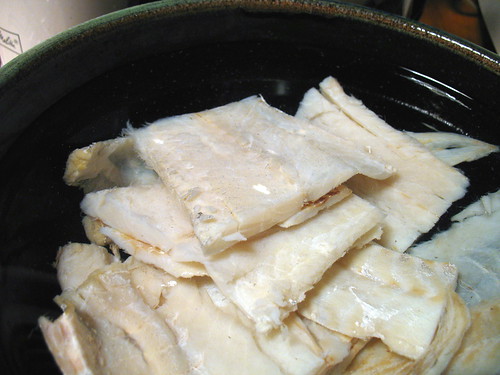
Another comment on the recipe: Try not to be alarmed by the quantity of garlic! You’re not going to eat it, you are just using it to infuse the simmering fish and the olive oil.
Finally, if you are not making this for a group of 6, I recommend scooping the finished brandade into small oven-safe dishes, as seen above. You can eat the leftovers cold but they are so much nicer warm, and this way you can warm up small portions as needed.
brandade de Morue
(recipe from chef Riad Nasr of Balthazar,
by way of evil Martha)
Serves 4 to 6
* 1 pound dried salt cod, cut into large pieces
* 4 dried bay leaves
* 2 sprigs fresh rosemary
* 12 sprigs fresh thyme
* 2 heads garlic, halved crosswise, outer paper removed
* 2 cups milk
* 1 cup water
* 1 pound Yukon gold potatoes, peeled and quartered
* 1/2 cup olive oil
* 1 cup plus 2 tablespoons heavy cream, warmed
* Garlic confit, for garnish [I skipped this with no regrets]
* Toasted croutons or bread
1. In large bowl, completely cover cod in water, and soak for at least 24 hours, changing water every 2 to 3 hours.
2. Make two bouquets garnis: For each, bunch 2 bay leaves, 1 sprig rosemary, and 6 sprigs thyme together, and tie with kitchen string. In a medium saucepan, place cod with 1 head of garlic, 1 bouquet garni, the milk, and 1 cup water. Over low heat, bring to simmer. Cook until fish is flaky, about 10 minutes. Drain, and discard garlic and bouquet garni. When cool enough to touch, flake fish, and set aside.
3. Place potatoes in medium saucepan, and cover with salted water. Cook potatoes at a simmer until fork-tender, 15 to 20 minutes, and drain.
4. In small saucepan, add oil, remaining head of garlic, and remaining bouquet garni. Over low heat, warm the oil, about 10 minutes. Discard garlic and bouquet garni.
5. Put potatoes through a food mill while still warm. In the bowl of an electric mixer fitted with the paddle attachment, combine potatoes and cod on low speed until just incorporated. Slowly add the infused oil, then add 1 cup cream. Do not overmix, or potatoes will become pasty. [I used a food processor for all of this and it turned out fine, but do be careful not to over-process.]
6. Garnish brandade with remaining 2 tablespoons warm cream and garlic confit. Serve with toasted croutons or bread.
I’m surprised I forgot to publish anything about brandade here last year because I was eager to share what I consider the highest and best use for the leftovers: in shatteringly crisp croquettes, to be served at breakfast or, surprise, with more drinks. With any luck they will be lightly crunchy on the outside with a dreamily fluffy interior, and you will think of them fondly even many months later.
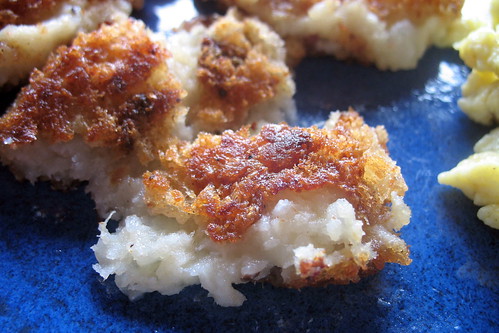
To make these, peel a russet potato, cut it into 1” pieces, and boil it in salted water until it’s very tender (approximately 12 minutes, but start testing it with the tip of knife after 10 minutes; there should be no resistance when you poke the largest piece through the center). Drain the potato, mash it with a fork, and blend it with however much leftover brandade you want to use. (Approximately one cup should work; the important thing is that the blended mixture should be stiff enough to hold a shape.) I also added a generous pinch of cayenne pepper. Form the mixture into little balls or patties with your hands and dip them in a beaten egg, then in fresh bread crumbs, turning gently to coat both sides. (If you aren't able to make fresh bread crumbs in a food processor, use panko instead). Pan fry the croquettes in a bit of peanut oil that’s been heated very hot but not smoking until they are golden brown on each side and very crisp around the edges. Transfer the cooked croquettes to a plate lined with paper towels to remove any excess oil and serve immediately.
A little chopped parsley on top is very very nice but not absolutely necessary. If you must make the croquettes ahead of time, keep them warm in a moderately hot oven (350° F or so) because they should be steaming hot inside. Really it is best to cook them at the last minute. They only take a few minutes to brown and they taste much better than they will if cooked in advance.




















